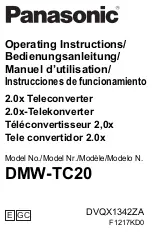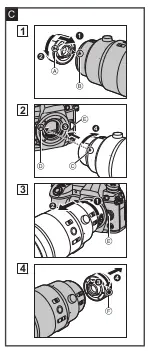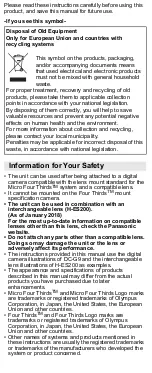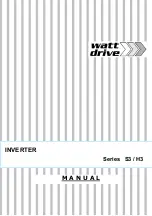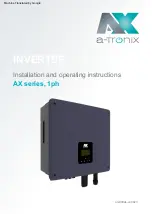
Please read these instructions carefully before using this
product, and save this manual for future use.
-If you see this symbol-
• The unit can be used after being attached to a digital
camera compatible with the lens mount standard for the
Micro Four Thirds
TM
system and a compatible lens.
• It cannot be mounted on the Four Thirds
TM
mount
specification camera.
• The unit can be used in combination with an
interchangeable lens (H-ES200).
(As of January 2018)
For the most up-to-date information on compatible
lenses other than this lens, check the Panasonic
website.
• Do not attach any parts other than a compatible lens.
Doing so may damage the unit or the lens or
adversely affect its performance.
• The instructions provided in this manual use the digital
camera illustrations of DC-G9 and the interchangeable
lens illustrations of H-ES200 as examples.
• The appearance and specifications of products
described in this manual may differ from the actual
products you have purchased due to later
enhancements.
• Micro Four Thirds
TM
and Micro Four Thirds Logo marks
are trademarks or registered trademarks of Olympus
Corporation, in Japan, the United States, the European
Union and other countries.
• Four Thirds
TM
and Four Thirds Logo marks are
trademarks or registered trademarks of Olympus
Corporation, in Japan, the United States, the European
Union and other countries.
• Other names of systems and products mentioned in
these instructions are usually the registered trademarks
or trademarks of the manufacturers who developed the
system or product concerned.
∫
Handling the unit
• The unit is designed to be dust- and splash-proof. Keep
the points below in mind when using the unit. If it is not
working properly, contact your dealer or nearest Service
Center.
– Attach the unit to a digital camera and lens that are
dust- and splash-proof before use. The unit is not
designed to be dust- and splash-proof when attached
to a digital camera and lens that are not dust- and
splash-proof.
– When attaching or removing the unit, be careful so
that foreign materials such as sand, dust, and water
droplets do not adhere to or enter the lens mount
rubber, the contact points, the digital camera or the
unit.
– The unit is not waterproof and therefore cannot be
used for underwater recording. The splash-proofing of
the unit is designed to minimize water entry. If the unit
is exposed to water splashes, wipe them off with a soft
dry cloth after use.
• To enhance the dust- and splash-proof performance of
the unit, a lens mount rubber is embedded in the mount.
As you attach and remove the unit many times, the lens
mount rubber may eventually leave its mark on the
mount of the digital camera body, but this will not affect
the performance of the digital camera. For information
about the replacement of the lens mount rubber, contact
your nearest Service Center.
• Do not press the lens surface of the unit with force.
• When there is dirt (water, oil, and fingerprints, etc.) on
the surface of the unit, the picture may be affected.
Lightly wipe the surface of the unit with a soft, dry cloth
before and after taking pictures.
• To prevent dust and other particles from accumulating
on or entering the unit, attach the lens rear cap when the
unit is not in use.
∫
About Condensation (Fogging of the Lens)
• Condensation occurs when the ambient temperature or
humidity changes. Please be careful, as it may cause
the lens to become dirty and lead to mould and
malfunctioning.
• If condensation occurs, turn the power off and leave it for
about two hours. Once the camera acclimatizes to the
surrounding temperature the condensation will go away
naturally.
Product numbers correct as of January 2018. These may
be subject to change.
1
Lens Pouch
2
Lens Cap
3
Lens Rear Cap
• The lens rear cap and lens cap are attached to the unit
at the time of purchase.
1
Fitting mark
2
Lens release button
3
Lens fitting mark
4
Contact points
• Do not place the unit with its contact points facing down
to protect them. In addition, be careful not to stain them.
5
Lens mount rubber
• Before attaching or removing the teleconverter,
verify that the digital camera is turned off.
• Remove the lens cap and the lens rear cap.
∫
To attach the teleconverter
(See illustration
/
)
1 Align the fitting mark
A
on the
teleconverter with the lens fitting
mark
B
on the interchangeable
lens (
1
), and rotate the
teleconverter in the arrow
direction until a clicking sound is
heard. (
2
)
2 Align the lens fitting mark
C
on
the teleconverter with the lens
fitting mark
D
on the digital
camera (
3
),
and rotate the lens in
the arrow direction until a clicking
sound is heard. (
4
)
• When attaching the lens to the digital camera, do not
press the lens release button
E
and the lens release
button on the teleconverter.
∫
To remove the teleconverter
(See illustration
/
)
1 While pressing and holding the
lens release button
E
on the
digital camera, rotate the lens
fitted with the teleconverter in the
arrow direction until it stops and
remove it (
1
,
2
).
2 While pressing and holding the
lens release button
F
on the
teleconverter, rotate the
teleconverter in the arrow
direction until it stops and
remove it (
3
,
4
).
Note
• When the teleconverter is mounted, the minimum
f-number will be set to a value two steps greater than the
original value.
• When updating the interchangeable lens firmware to the
latest version, remove the teleconverter before
performing the update.
When carrying the unit, do not drop it or hit it against
a hard surface. In addition, take care not to apply
excessive pressure on the unit.
• Be careful not to drop the bag containing the unit or hit it
against a hard surface, as doing so will expose the unit
to impact. Otherwise, the unit may stop operating
correctly or pictures may no longer be recorded.
Damage to the unit may also result.
When using pesticides and other volatile substances
around the camera make sure that they do not get
onto the unit.
• If such substances get onto the unit they can damage
the exterior case or cause the paint to peel.
Do not point the unit at the sun or other strong light
sources.
• This could cause the unit to collect an excessive amount
of light, resulting in fire and malfunction.
• Avoid using or storing the unit in any of the following
locations as this may cause problems in operation or
malfunctioning:
– In direct sunlight or on a beach in summer
– In locations with high temperatures and humidity
levels or where the changes in temperature and
humidity are acute
– In locations with high concentrations of sand, dust or
dirt
– Where there is fire
– Near heaters, air conditioners or humidifiers
– Where water may make the unit wet
– Where there is vibration
– Inside a vehicle
• Refer also to the operating instructions of the digital camera.
• When the unit is not going to be used for a prolonged
period, we recommend storing with a desiccant (silica
gel). Failure to do so may result in performance failure
caused by mold, etc. It is recommended that you check
the unit’s operation prior to use.
• Do not leave the unit in contact with rubber or plastic
products for extended periods of time.
• Do not touch the unit’s contact points. Doing so may
cause malfunction.
• Do not disassemble or alter the unit.
Do not leave the unit in direct contact with the skin in
cold temperatures for long periods of time.
• In cold locations (environments below 0
o
C (32
o
F), such
as ski slopes), prolonged direct contact with the metal
parts of the unit may cause skin injury. Use gloves or
similar when using the unit for long periods of time.
Do not use benzine, thinner, alcohol or other similar
cleaning agents to clean the unit.
• Using solvents can damage the unit or cause the paint to
peel.
• Wipe off any dust or fingerprints with a soft, dry cloth.
• Use a dry, dust-free cloth to remove dirt and dust on the
lens mount rubber.
• Do not use a household detergent or a chemically
treated cloth.
Specifications are subject to change without notice.
2.0x Teleconverter (DMW-TC20)
Bitte lesen Sie diese Anleitung vor der Inbetriebnahme
dieses Produkts aufmerksam durch, und bewahren Sie
dieses Handbuch für spätere Bezugnahme griffbereit auf.
-Bedeutung des nachstehend abgebildeten Symbols-
• Das Gerät kann verwendet werden, wenn es mit einem
kompatiblen Objektiv sowie einer Digitalkamera verbunden
wird, welche mit dem Objektivanschluss-Standard für das
Micro Four Thirds
TM
-System kompatibel ist.
• Objektive dieser Ausführung lassen sich nicht auf
Kameras mit Four-Thirds
TM
-Bajonett aufsetzen.
• Das Gerät kann in Kombination mit einem
austauschbaren Objektiv (H-ES200) verwendet
werden. (Stand: Januar 2018)
Aktuelle Informationen zu weiteren kompatiblen
Objektiven finden Sie auf der Website von
Panasonic.
• Bringen Sie keine anderen Objekte als kompatible
Objektive an. Anderenfalls kann es zu
Beschädigungen des Geräts und des Objektivs
sowie zu Leistungsbeeinträchtigungen kommen.
• In den Abbildungen in diesem Handbuch sind
beispielhaft die Digitalkamera DC-G9 und das
austauschbare Objektiv H-ES200 dargestellt.
• Ausstattung und technische Daten der von Ihnen
erworbenen Produkte können aufgrund technischer
Weiterentwicklungen von der Ausstattung und den
technischen Daten der in diesem Handbuch
beschriebenen Produkte abweichen.
• Micro Four Thirds
TM
und die für Micro Four Thirds
verwendeten Logos sind Markenzeichen oder
eingetragene Markenzeichen der Olympus Corporation
in Japan, den USA, der EU und anderen Ländern.
• Four Thirds
TM
und die für Four Thirds verwendeten
Logos sind Markenzeichen oder eingetragene
Markenzeichen der Olympus Corporation in Japan, den
USA, der EU und anderen Ländern.
• Andere Namen von Systemen oder Produkten welche in
dieser Bedienungsanleitung genannt werden, sind
normalerweise Warenzeichen oder eingetragene
Warenzeichen der Hersteller dieser Produkte oder Systeme.
∫
Handhabung des Geräts
• Dieses Gerät ist auf Staub- und Spritzwasserdichtigkeit
ausgelegt. Behalten Sie folgende Punkte im Kopf, wenn
Sie das Gerät verwenden. Wenn das Gerät nicht korrekt
funktioniert, wenden Sie sich an Ihren Händler oder das
nächstgelegene Service-Center.
– Bringen Sie das Gerät an eine Digitalkamera und ein
Objektiv an, die beide staub- und spritzwasserdicht
sind. Das Objektiv ist nicht auf Staub- und
Spritzwasserdichtigkeit ausgelegt, wenn es an einer
Digitalkamera und an einem Objektiv angebracht wird,
die nicht staub- und spritzwasserdicht sind.
– Achten Sie beim Anbringen und Entfernen des Geräts
darauf, dass keinerlei Fremdmaterial wie Sand, Staub,
Wassertropfen usw. auf Objektivfassungsgummi,
Kontaktpunkte, Digitalkamera oder Gerät gelangt.
– Das Gerät ist nicht wasserdicht und kann nicht zu
Unterwasser-Aufnahmen verwendet werden. Die
Spritzwasserdichtigkeit des Geräts ist auf die
Minimierung von Wassereintritt ausgelegt. Wenn das
Gerät Spritzwasser ausgesetzt ist, wischen Sie es nach
der Verwendung mit einem weichen trockenen Tuch ab.
• Zur Verbesserung der Staub- und Spritzwasserdichtigkeit
des Geräts ist ein Objektivfassungsgummi an der
Anschlussposition angebracht. Wird das Gerät mehrfach
angebracht und entfernt, entsteht durch das
Objektivfassungsgummi möglicherweise ein Abdruck an
der Anschlussposition des Digitalkamera-Gehäuses.
Dadurch wird die Leistungsfähigkeit der Digitalkamera
jedoch nicht beeinträchtigt. Informationen zum Ersetzen
des Objektivfassungsgummis erhalten Sie beim
nächstgelegenen Service-Center.
• Üben Sie keinen starken Druck auf die Objektivseite des
Geräts aus.
• Ist die Oberfläche des Geräts verschmutzt (durch
Wasser, Öl, Fingerabdrücke usw.), kann dies die
Bildqualität beeinträchtigen. Wischen Sie die Oberfläche
des Geräts vor und nach dem Fotografieren vorsichtig
mit einem weichen trockenen Tuch ab.
• Bringen Sie den hinteren Objektivdeckel an, wenn das
Gerät nicht verwendet wird, damit keine Staub- oder
anderen Partikel auf die Linse oder in das Gerät geraten.
∫
Hinweise zu Kondensation
(Beschlagen des Objektivs)
• Kondensation tritt auf, wenn sich Umgebungstemperatur
oder Luftfeuchtigkeit ändern. Seien Sie vorsichtig, da es
anderenfalls zu Verschmutzungen des Objektivs, zu
Schimmelbildung und Fehlfunktionen kommen kann.
• Wenn sich Kondensation bildet, schalten Sie die Kamera
aus und lassen Sie sie für etwa zwei Stunden
ausgeschaltet. Die Kondensation baut sich während der
Anpassung der Kamera an die Umgebung auf
natürlichem Wege ab.
Die Produktnummern beziehen sich auf den Stand von
Januar 2018. Änderungen sind vorbehalten.
1
Objektivbeutel
2
Objektivdeckel
3
Hinterer Objektivdeckel
• Objektivdeckel und hinterer Objektivdeckel sind zum
Kaufzeitpunkt am Gerät angebracht.
1
Befestigungsmarkierung
2
Objektiv-Entriegelungstaste
3
Markierung zum Ansetzen des Objektivs
4
Kontaktpunkt
• Platzieren Sie das Gerät nicht mit den Kontaktpunkten
nach unten weisend. Ansonsten kann es zu
Beschädigungen kommen. Achten Sie außerdem
darauf, dass die Kontaktpunkte sauber sind.
5
Objektivfassungsgummi
• Bevor Sie den Telekonverter anbringen bzw.
entfernen, vergewissern Sie sich, dass die Digital-
Kamera ausgeschaltet ist.
• Entfernen Sie den Objektivdeckel und den hinteren
Objektivdeckel vom Objektiv.
∫
Anbringen des Telekonverters
(Siehe Abbildung
/
)
1 Richten Sie die
Befestigungsmarkierung
A
am
Telekonverter an der
Befestigungsmarkierung
B
am
Objektiv aus (
1
). Drehen Sie den
Telekonverter in Pfeilrichtung, bis
ein Klickgeräusch ertönt. (
2
)
2 Richten Sie die
Befestigungsmarkierung
C
am
Telekonverter an der
Befestigungsmarkierung
D
an
der Digital-Kamera (
3
) aus.
Drehen Sie das Objektiv in
Pfeilrichtung, bis ein
Klickgeräusch ertönt. (
4
)
• Wenn Sie das Objektiv an der Digital-Kamera anbringen,
bedienen Sie weder die Entriegelungstaste
E
des
Objektivs noch die Entriegelungstaste des
Telekonverters.
∫
Entfernen des Telekonverters
(Siehe Abbildung
/
)
1 Halten Sie die Entriegelungstaste
E
des Objektivs an der Digital-
Kamera gedrückt, drehen Sie das
mit dem Telekonverter
verbundene Objektiv so weit wie
möglich in Pfeilrichtung und
entfernen Sie es (
1
,
2
).
2 Halten Sie die Entriegelungstaste
F
des Telekonverters gedrückt,
drehen Sie den Telekonverter so
weit wie möglich in Pfeilrichtung
und entfernen Sie ihn (
3
,
4
).
Hinweis
• Wenn der Telekonverter angebracht ist, wird die
minimale f-Nummer auf zwei Schritte über dem
Originalwert eingestellt.
• Soll die Firmware des Objektivs auf eine neue Version
aktualisiert werden, so entfernen Sie den Telekonverter
vor dem Update.
Wenn Sie das Gerät tragen, achten Sie darauf, dass es
weder herunterfällt noch mit harten Oberflächen
kollidiert. Achten Sie außerdem darauf, keinen
übermäßigen Druck auf das Gerät auszuüben.
• Achten Sie darauf, dass die Tasche mit dem Gerät darin
weder herunterfällt noch mit harten Oberflächen
kollidiert, da es anderenfalls zu übermäßigen
Erschütterungen des Geräts kommen kann. In diesem
Fall funktioniert das Gerät möglicherweise nicht mehr
korrekt, oder es werden keine Bilder mehr
aufgenommen. Außerdem sind Beschädigungen des
Geräts möglich.
Wenn Sie in der Nähe der Kamera Pestizide oder
andere flüchtige Substanzen verwenden, achten Sie
darauf, dass diese Substanzen nicht an die Kamera
gelangen.
• Anderenfalls können Kameragehäuse sowie Lackierung
beschädigt werden.
Richten Sie das Gerät nicht direkt auf die Sonne oder
andere starke Lichtquellen.
• Anderenfalls nimmt das Gerät möglicherweise
übermäßig viel Licht auf, und es kann zu Bränden und
Fehlfunktionen kommen.
• Verwenden und lagern Sie das Gerät nicht unter den
folgenden Bedingungen, da es ansonsten zu
Bedienproblemen und Fehlfunktionen kommen kann:
– Bei direktem Sonnenlicht oder im Sommer an der
Küste
– An Orten mit hohen Temperaturen und hoher
Feuchtigkeit, bzw. wo starke Änderungen bei
Temperatur und Feuchtigkeit erfolgen
– An Orten mit hoher Konzentration von Sand, Staub
oder Schmutz
– Bei einem Brand
– In der Nähe von Heizkörpern, Klimaanlagen oder
Luftbefeuchtern
– Wo Wasser das Gerät benässen kann
– Wo Erschütterungen vorhanden sind
– In einem Fahrzeug
• Weiter Informationen finden Sie auch in der
Bedienungsanleitung der Kamera.
• Wenn für längere Zeit kein Einsatz erfolgt, lagern Sie
das Objektiv gemeinsam mit einem Trocknungsmittel
(Silica-Gel). Ohne ausreichende Trocknung kann die
Einsatzfähigkeit des Objektivs durch Schimmel usw.
beeinträchtigt oder der Einsatz völlig unmöglich werden.
Es wird empfohlen, die Funktionsfähigkeit des Gerätes
vor dem Gebrauch zu prüfen.
• Bringen Sie das Gerät nicht über längere Zeiträume mit
Gegenständen aus Gummi oder Kunststoff in Kontakt.
• Berühren Sie nicht die Kontaktpunkte des Geräts.
Anderenfalls kann es zu Fehlfunktionen kommen.
• Verändern und zerlegen Sie dieses Gerät nicht.
Vermeiden Sie bei kalten Temperaturen Hautkontakt
mit dem Gerät über längere Zeiträume.
• In kalten Umgebungen (unter 0
o
C wie Skipisten) kann
ein längeres Berühren der Metallteile des Geräts zu
Hautverletzungen führen. Tragen Sie Handschuhe o. ä.,
wenn Sie das Gerät über einen längeren Zeitraum
hinweg verwenden.
Verwenden Sie zum Reinigen des Geräts kein
Waschbenzin, keinen Verdünner, keinen Alkohol oder
ähnliche Reinigungsmittel.
• Lösemittel können zu Beschädigungen des Geräts und
zu Ablösungen der Lackierung führen.
• Wischen Sie Staub oder Fingerabdrücke ggf. mit einem
weichen trockenen Tuch ab.
• Verwenden Sie ein trockenes staubfreies Tuch, um
Schmutz und Staub vom Objektivfassungsgummi zu
entfernen.
• Verwenden Sie keine Haushaltsreiniger und keine
chemischen Reinigungstücher.
Die Spezifikationen können ohne Ankündigung geändert
werden.
2.0x-Telekonverter (DMW-TC20)
Disposal of Old Equipment
Only for European Union and countries with
recycling systems
This symbol on the products, packaging,
and/or accompanying documents means
that used electrical and electronic products
must not be mixed with general household
waste.
For proper treatment, recovery and recycling of old
products, please take them to applicable collection
points in accordance with your national legislation.
By disposing of them correctly, you will help to save
valuable resources and prevent any potential negative
effects on human health and the environment.
For more information about collection and recycling,
please contact your local municipality.
Penalties may be applicable for incorrect disposal of this
waste, in accordance with national legislation.
Information for Your Safety
1
2
3
4
ENGLISH
Precautions
A
Supplied Accessories
B
Names and Functions of
Components
C
Attaching/Removing the
Teleconverter
Cautions for Use
Specifications
Focal length
2.0
k
that of the attached lens.
Lens construction
8 elements in 5 groups
Max. diameter
Ø58 mm (2.3 inch)
Overall length
Approx. 34 mm (1.3 inch) (from the tip of the lens to the
base side of the lens mount)
Mass
Approx. 160
g
(0.353 lb)
Operating temperature
j
10
o
C to 40
o
C (14
o
F to 104
o
F)
Dust-proof and splash-proof
Available
Entsorgung von Altgeräten
Nur für die Europäische Union und Länder mit
Recyclingsystemen
Dieses Symbol, auf den Produkten, der
Verpackung und/oder den
Begleitdokumenten, bedeutet, dass
gebrauchte elektrische und elektronische
Produkte nicht in den allgemeinen Hausmüll
gegeben werden dürfen.
Bitte führen Sie alte Produkte zur
Behandlung, Aufarbeitung bzw. zum Recycling gemäß
den gesetzlichen Bestimmungen den zuständigen
Sammelpunkten zu.
Indem Sie diese Produkte ordnungsgemäß entsorgen,
helfen Sie dabei, wertvolle Ressourcen zu schützen und
eventuelle negative Auswirkungen auf die menschliche
Gesundheit und die Umwelt zu vermeiden.
Für mehr Informationen zu Sammlung und Recycling,
wenden Sie sich bitte an Ihren örtlichen
Abfallentsorgungsdienstleister.
Gemäß Landesvorschriften können wegen nicht
ordnungsgemäßer Entsorgung dieses Abfalls
Strafgelder verhängt werden.
Informationen für Ihre Sicherheit
Vermeidung von Störungen
DEUTSCH
A
Beiliegendes Zubehör
B
Bezeichnungen und Funktionen
der einzelnen Kamerateile
C
Anbringen/Entfernen des
Telekonverters
Vorsichtsmaßnahmen
Spezifikationen
Brennweite
2,0
k
Wert des angebrachten Objektivs.
Objektivaufbau
8 Elemente in 5 Gruppen
Max. Durchmesser
Ø58 mm
Gesamtlänge
Ca. 34 mm (vom vorderen Ende des Objektivs bis zum
Ende des Objektivbajonetts)
Gewicht
Ca. 160
g
Betriebstemperatur
j
10
o
C bis 40
o
C
Staub- und spritzwasserdicht
Ja
Operating Instructions/
Bedienungsanleitung/
Manuel d’utilisation/
Instrucciones de funcionamiento
2.0x Teleconverter
2.0x-Telekonverter
Téléconvertisseur 2,0x
Tele convertidor 2.0x
Model No./Model Nr./Modèle/Modelo N.
DMW-TC20
Manufactured by:
Panasonic Corporation
Kadoma, Osaka, Japan
Importer for Europe: Panasonic Marketing
Europe
GmbH
Panasonic Testing Centre
Winsbergring 15, 22525
Hamburg,
Germany
until
2018/02/28
DVQX1342ZA
F1217KD0
E
GC
Panasonic Corporation
Web Site: http://www.panasonic.com
Panasonic Corporation 2018
1
DVGX1115Z
2
3
VFC4605
VFC4460
1
4
5
2
3
DVQX1342ZA_E.fm 1 ページ 2017年12月14日 木曜日 午後3時31分
Summary of Contents for DMW-TC20
Page 2: ...1 DVGX1115Z 2 3 VFC4605 VFC4460 1 4 5 2 3 ...
Page 3: ...1 2 3 4 ...

